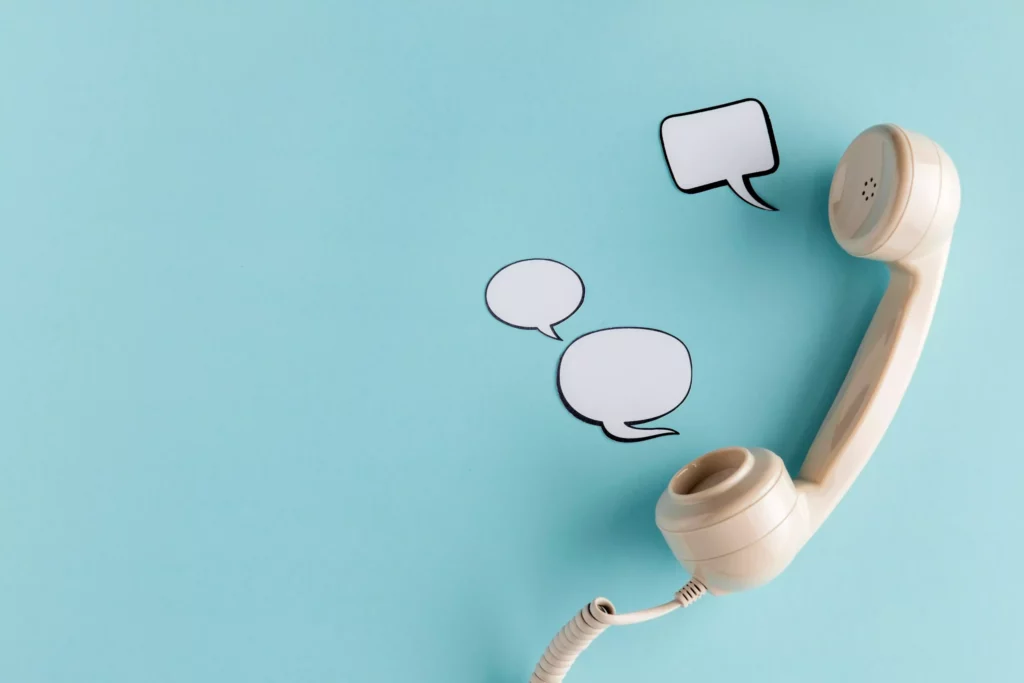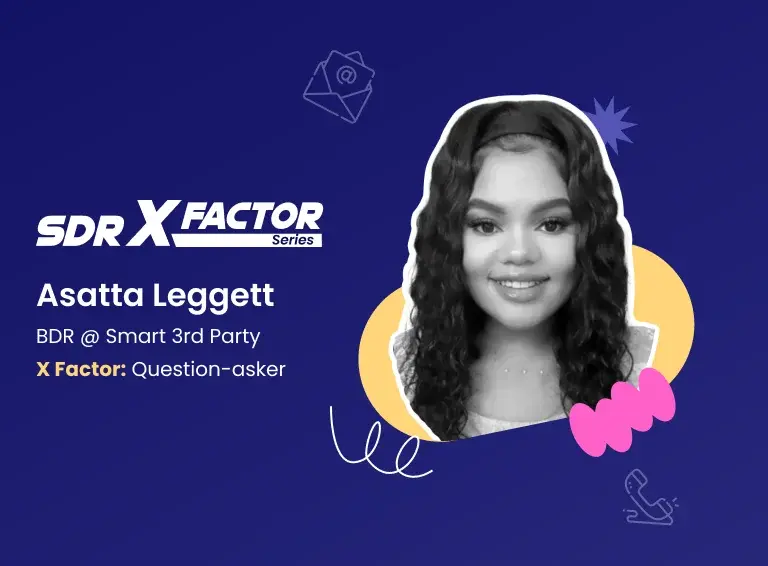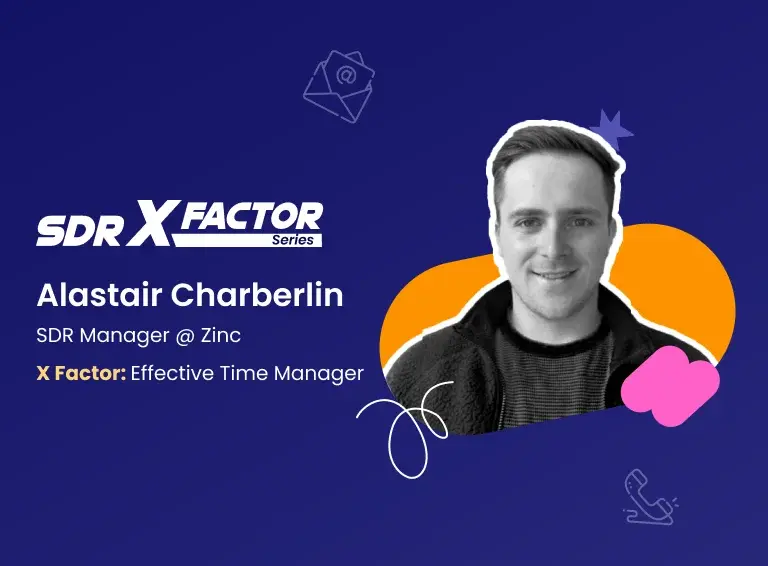The SDR X Factor is a series of long-form stories that aims to reveal what sets top-performing sales reps apart. How do they go about their day? What do their cold calling and cold emailing strategies look like? How are they crushing quota every time? We extract their key strategies, tips and tricks so you can sell better.
In the seventh installation of this series, we meet Aamir Sohail, a top-performing SDR at Vervotech, a SaaS-based travel technology company providing travel data management solutions like hotel and room mapping, and hotel-curated content.
As a Travel Tech Advisor, he is part of the inside sales team of Vervotech that does outbound sales. We had a chat with Aamir to discover how he crushes his quotas and what drives him.
1. From Hospitality to Sales

Having completed his bachelor’s in hotel management, Aamir worked in the hospitality industry for over a year in a client-facing role. “I enjoyed interacting with clients from all over the world every single day,” he reminisces.
While getting to work with salespeople during this stint, he was attracted towards the process of pitching a product to customers and wanted to try his hands in sales as well. This motivated him to complete his MBA and land his first sales job, where he worked as a field sales rep for Bennett, Coleman and Co. Ltd, one of India’s largest media conglomerates. “It helped me understand the core skills required in sales,” he says.
After 2 years in the field sales role, he shifted to his current inside sales role at Vervotech, where he reaches out to the U.S. market. Aamir has exceeded his monthly quota for 3 consecutive months (June, July and August), and is now among the top-performing SDRs in his organization.
i) What Sets Him Apart?
- Remains highly motivated
For Aamir, sales is instant gratification. Being a salesperson, he draws motivation from being able to see the results of his efforts almost instantly. “When I see any of my deals closing or when I see the revenue numbers going up, and it is accredited to me, it really makes me feel happy and extremely motivated to work more,” he says.
- Being able to gauge the prospect’s mood during a call
For an SDR, having an idea of paralanguage—a form of non-verbal communication that includes observing the speaker’s tone and inflection—will go a long way in gauging the prospect’s mood during a call. Here, Aamir’s experience in field sales comes in handy, as he can judge whether the prospect is interested or not by listening to how the “Hello?” sounds, and tweak his pitch accordingly.
“If it’s an aggressive ‘Hello?’, I will stick to just a few words,” he says, noting that for such prospects who sound like they’re in a hurry, he would have just a one-line pitch: “We are this company and we do this, and we think we have an approach for you. Would you be interested?”
On the other hand, if the prospect’s “Hello?” is a bit gentler and hints at curiosity, he would engage the prospect more and understand their pain points better.
2. Breaking Down Aamir’s Cold Calling Secrets
As part of his outreach, Aamir makes between 40 to 50 cold calls in a day. 80% of these calls get some kind of response while the rest goes to voicemail. Either the prospect or someone else from the prospect’s company usually picks up. So, let’s see what he gets right with his calls:

i) Sends 2 Emails Before Calling a Prospect
To warm his cold calls up, Aamir usually sends two emails to a prospect prior to calling them, so that is some kind of familiarity. “The call is the third step in our cadence,” he says. A high-intent prospect would have likely interacted a couple of times with the emails, he notes. Talking about the emails he sent also allows him to break the ice.
ii) Timeblocks for Prospecting
Aamir dedicates the first half of his workdays to prospecting alone, as it requires his full attention. During this, he researches an account for about 5 minutes and adds the accounts to his cadence using the sales engagement platform Klenty. “It’s an all-in-one tool for us where we create our cadences with personalized emails, LinkedIn connection requests, cold calls, everything set up in one platform,” he says.
iii) Plans for a 3-Minute Call
On average, Aamir’s cold calls last for about 3 minutes. So, he plans an array of questions and one-liners for the call.
Before calling, he takes a quick look at the prospect’s LinkedIn profile so that he can add inputs to his cold calling script to make it more personalized. He prepares two kinds of opening lines for the prospects based on whether they have interacted with his emails or not. For those who have opened his emails, he would say that the call is regarding a couple of emails that he sent about hotel mapping, so that the prospect has an “immediate recall.” To those who haven’t, he has a straightforward opener: “I'm from Vervotech, a travel technology company, and they help travel businesses such as yours to optimize their hotel mapping.”
Next, he asks some preliminary questions to qualify the prospect. Towards the end of the call, he also makes sure to mention the next touchpoint—whether it is a callback, or an email or a product demo—clearly.
iv) Focuses on Educating the Prospect During Objections
While handling objections, Aamir focuses on educating the prospect more than anything else. Explaining key facts to the prospect instead of saying something negative helps him to sell his product better, he says. Here are the top 5 objections he handles while cold calling:
a) Objection: “I’m Not Sure if We Need This at the Moment.”
“It is a clear indication that they are not aware of what exactly the product is,” he says. After hearing this objection, he goes on to explain the salient features of the product as part of the conversation.
b) Objection: “Our Technology Team Is Taking Care of {Pain Point} And It Seems To Be Working Fine.”
According to him, this shows that the prospect knows what the product is, but they're not sure about the additional value of his product that can be of use to them. “I try to highlight the USP of our product versus whatever the approach they have right now.”
c) Objection: “We’re Already Using a Competitor of Yours, I Think We’re Good.”
Upon hearing this, he focuses on highlighting the strengths of his product instead of diminishing the competitor’s product. He uses lines like “That’s a great one, but do they have this that we have?” or “How important is customer service to you? Because we are very proud of our customer service.”
d) Objection: “This Is Not the Right Time.”
When a prospect says this, the immediate response from him is to say “Not a problem at all” politely. Then, he would ask them what time would work for them for a discussion—even if it’s a few months away—and let them know that they would be receiving an email/call on this particular date.
e) Objection: “I’m Not the Right Person.”
Once Aamir hears this during the call, his first instinct is to find out whether he has reached out to the right company or not. To gauge this, he prolongs the conversation for about 15 more seconds.
If the company isn’t the one he was trying to reach, he would check with the person on the phone line whether the company is in the travel business and if it is, he’d freshly introduce himself and go ahead with his usual pitch. If the business is not in the travel domain, he’d apologize and disconnect the call.
On the other hand, if the person says that it’s the right company, he tries to know who the decision maker is. “They usually help, and if I'm lucky, I get a direct reference or an email address of the correct person,” he says.
v) Makes Gatekeepers Responsible for Passing His Message:
Handling gatekeepers can be tricky, as Aamir has learned from his experience. They certainly don’t entertain sales calls and they might not deliver your intended message to the decision maker.
So, once he reaches a gatekeeper, Aamir convinces them that he had previously reached out through emails and persuades them to pass on the message to the decision maker. If the gatekeeper suggests to reach the decision maker through voicemail, he says: “That's okay, you don't need to give me the voicemail, if you can just pass this message on to him, that Aamir from Vervotech has called.” This way, he tries to “create a sense of responsibility” as the gatekeeper feels responsible to deliver the message to the decision maker.
In addition, he checks with the gatekeeper if they could answer an “yes-or-no” type question about the company—about its partners or how they book hotels. If the gatekeeper answers, he uses it to qualify whether the account is an SQL or not and uses the information while reaching out to the decision maker at a later time.
vi) Builds Rapport by Discussing Pain Points:
As part of his approach to building rapport with prospects, particularly C-level executives, Aamir drives the discussion towards their pain points and how they are trying to solve their problems, instead of pitching his product right away.
Only while discussing the possible solutions for the pain points, when the moment is right, he goes ahead to pitch his product. “I get an option to pitch my product to them, but I let them bring it to that point,” he notes. This way, he’s better equipped to book a product demo with the prospect by the end of the call.
vii) Worst Cold Call Experience:
“Once, I called up a CEO, and it reached his secretary. She couldn’t get my name right and pronounced it wrongly in front of his boss and transferred the call to him. As I introduced myself, he got furious at me and accused me of calling him using a fake name or a pseudo name because he recognizes my name from the emails.
Even though he was shouting and screaming at me, I kept my cool and after a good 30 seconds, explained to him how both the names sound similar and there might have been a mistake in hearing. It was a little disturbing to be yelled at, but it was a learning experience.”
viii) Aamir’s Tips From His Successful Cold Calling Journey:
a) Never Ask Closed-Ended Questions
In his early days as an inside salesperson, Aamir found little to no success by asking questions such as “Would you be interested?” “Is it a good time to talk?” and “Do you have any plans?.” He later realized that such closed-ended questions mostly elicit “No” than “Yes” from prospects and now focuses on using more open-ended liners.
For example, instead of “Is it a good time to talk?” he says: “I know you were not expecting my call, but this is in regards to...” to clear the air.
b) Avoids Asking For Phone Numbers
When he reaches the wrong person or a gatekeeper, one thing he avoids is asking for the prospect’s direct contact numbers. “I feel that is a red flag for any company. No one gives their personal numbers or their colleague’s official number for that matter,” he says.
c) Make the Prospect Interested in Your Product
Instead of just focusing on handling objections, Aamir says that he tries to go a step further and create an interest in the prospect’s mind about his product. “Even if they have one particular question about the product, I may answer it partially with a hook to come to the product demo so they can understand it better ,” he explains.
3. Aamir’s Cold Emailing Process
“Emails are generating responses even while I am asleep, so it’s kind of a passive source for responses. Emails have worked best for me,” he says.
Email engagement metrics like opens, bounces and unsubscribes are the first task on his to-do list when he clocks in. “If I see there’s a drop in the numbers in terms of engagement, I tweak the email subject lines or content of the next emails in that particular cadence,” he says.
Aamir sends around 50 cold emails every day, and it could go up to 120 emails on some days. “I run multiple sequences per day, and every alternate day, there are emails sent. If I start one email today, the next email will be sent in two days from now,” he says.
Let’s now delve into some of the major takeaways from his cold emailing process:

i) Attaches Product Screenshots To Personalize Emails
When it comes to image personalization, Aamir generally attaches a screenshot of his product with his cold email, as he feels that he can convey so much about the product by showing how it looks, instead of elaborating it in words that’d make the emails bulky.
“The right people, like the technology experts of the company or CTOs, can gauge the product by seeing the dashboard. So instead of me explaining each and every feature on call, I simply sent a snapshot for them to judge and it has been working great,” he says.
Do you use GIFs in emails?: “I use GIFs only while reaching out on LinkedIn and not in emails, because I feel the crowd on LinkedIn is more receptive towards GIFs.”
ii) Digs Deep Into LinkedIn To Personalize Better
LinkedIn, as we can all agree, is a treasure trove of valuable information that can be used to personalize emails. One of Aamir’s success stories demonstrates this.
While researching one of his prospects on LinkedIn, he gathered that the prospect was a cat person. So in his cold email, he wrote: “I’m attaching two images. One is a product snapshot, and another one is of my cat, just in case.” The prospect replied that they were impressed and agreed to a product demo.
iii) Pays Attention to the Tone of Email Content
While personalizing the email body, he makes sure that the tone is appropriate to the prospect. For instance, if the prospect is over 60 years of age, the email tone would sound more professional and formal; if the prospect is a young CEO in their 20s or 30s, the tone would be more casual. He uses tools like Crystal and Grammarly to get the tone right.
iv) Mentions Prospect’s Company or First Name in Subject Lines
For first name personalization, he uses a format like (“{first name}, your thoughts on [topic]?”) and for company name personalization, he goes with the “plus format” (“Vervotech + {company name}: Hotel Mapping”).
Aamir ensures that his subject lines do not exceed 6 words to make it mobile-friendly and carries out A/B testing using the sales engagement platform, Klenty. He does not use emojis in his subject lines as he considers them unprofessional. “No one is expecting an emoji on their business emails. It is more of a personal mailbox thing,” he opines.
v) Doesn’t Ask for a Meeting in Every Email
For each prospect, Aamir sends between 6 and 7 emails in a sequence as part of a month-long campaign. Among these, he finds that the first emails generally get more responses from his prospects.
“I do not include so much detail of my product in the first mail itself. And I do not include many links in the first email. There are just 1 or 2 lines of introduction of the company, what we do, and how we plan to solve their problem,” he elaborates.
In his follow-up emails, he begins to include links and other sales enablement material. The second email will include three links—a video, a walkthrough of his platform, and a case study on why some businesses may require his product. The second email has the maximum amount of material to “educate” the prospect, he explains.
He avoids directly asking for a meeting in any of his emails. While his email signature has a Calendly link, he includes a Calendly link in the email body from the third email to allow the prospects to schedule a meeting based on their convenience. “Asking a question in every email is not beneficial for me. Instead, I give them the choice,” he says.
vi) Frames His Breakup Email Template To Get Inputs From Prospects
At the end of his sequence, Aamir sends a breakup email to the prospect as a last-ditch effort to get replies. As part of his breakup email template, he frames the subject line as, “{First name}, here's my last email.”
He begins his breakup email with the lede: “There is a very thin line between persistence and pestering. I don't want to cross that line. So, this will be my final email for some time now.”
4. Tête-à-Tête With Aamir

i) One Thing That You Will Not Compromise on When It Comes to Work-Life Balance?
“I strictly do not push any pending tasks for the weekends. I make sure I never ever end up with too many things to do on a Friday.”
ii) What Do You Do After Work To Rejuvenate Yourself?
“I play Call of Duty with my friends almost every single day. A good gaming session after a long day is the best form of relaxation for me.”
iii) People You Follow on LinkedIn for Insights on Sales?
“Ian Koniak, Josh Braun, and Charlotte Johnson.”
iv) Best Sales Advice You’ve Ever Received?
“I read somewhere on Reddit: “Qualify hard, close easy.” If you're spending so much time in qualifying the right people, the chances of closing the deal are easy.”
Interviewed and written by: Akileish R





